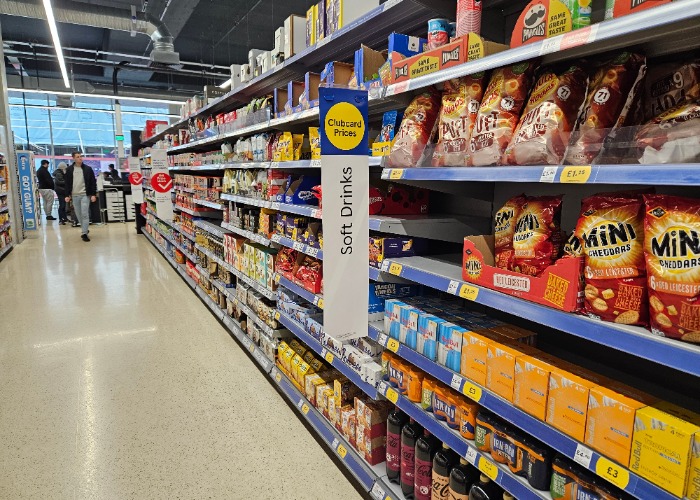Tesco: supermarkets in new price lock promises as food price inflation drops

Tesco is the latest food outlet to promise prices will be locked until the new year, but greater numbers of own brand options would be a big boost to budget-conscious shoppers.
Tesco has confirmed it is locking the price of more than 1,000 products until next year, in a move it said is aimed at supporting households during the cost of living crisis.
The products included in the price lock include a host of household staples, like teabags, toothpaste and washing up liquid.
The price lock comes after a host of price cuts to hundreds of products in recent months.
Here is a selection of the products that have had their prices locked until the new year.
|
Product |
Locked price |
|
Typhoo 100 one cup teabags |
£1 |
|
Aquafresh Freshmint Toothpaste 75ml |
80p |
|
Jacobs’ Cream Crackers 300g |
£1.70 |
|
Easy Seriously Thick Bleach |
55p |
|
Fairy Original washing up liquid 645ml |
£2 |
|
Kellog’s Bran Flakes 750g |
£3 |
|
Daddies Brown Sauce 400g |
£1.30 |
|
Birds Eye 4 breaded cod cakes |
£1.40 |
|
Cadbury Timeout biscuits x6 |
£1.30 |
|
Heinz Cream of Tomato Soup 300g |
£1 |
Jason Tarry, UK CEO of the supermarket giant, said the firm was well aware this has been a “year of budgeting carefully for shoppers”, and so it wanted to provide “great value” to shoppers.
Standing out from the crowd
It’s worth noting that price cuts or freezes are just one of the tactics employed by supermarkets like Tesco of late.
For example, Tesco also trumpeted its scheme where it price-matches a host of items with deep discounter Aldi, noting that it has recently expanded the scheme to include hundreds more items.
It’s been a similar story from Sainsbury’s, which has its own price match programme with Aldi, and which has also been expanded of late to the point that it now includes 400 products.
Across the board supermarkets have looked for ways to appeal to shoppers who are hoping to save a few quid on their food shopping, recognising that we are all feeling the pinch.
Iceland last week also announced price cuts on more than 1,000 products, and it’s not just the big names either.
Getir, the rapid food delivery service, has also announced price cuts to more than 100 essential household items.
Inflation has peaked
It would appear that the worst of food price inflation is now behind us.
The latest data from the Office for National Statistics shows that food price inflation dropped in August to 13.6%, down from 14.9% in July and the high of 19.2% in March.
That’s clearly welcome, since it means that prices are not racing away at quite the same rate as has been seen in recent months.
It’s important to bear in mind that this doesn’t mean prices are falling though ‒ they are simply going up at a slower pace.
As a result, if you aren’t making changes to your shopping habits then you are going to still see the cost of your trip to the supermarket going up.
Moving to own brands
One of the most common tactics for shoppers looking to save some cash is to switch the brands they buy. After all, we pay a premium for those big-name brands compared with own brands.
Just this week Aldi suggested that own-brand products now make up more than half of everything shoppers are buying, in terms of both value and volume.
In fact, the budget store suggested that sales of own-label items are growing at twice the rate of branded goods.
The fact that they are available at that cheaper price point makes this particular change to our habits something of a no-brainer, though doing so is reliant on availability.
After all, you can’t purchase own-brand items if your local supermarket doesn’t stock them.
And it’s here that many of the big supermarkets are failing to hold up their end of the bargain.
Which? has previously criticised supermarkets for doing a poor job in stocking enough own-brand items, particularly in the local convenience stores.
While you can generally take advantage of the budget-friendly own-brand products when shopping online, the reality can be rather different when shopping in person at a smaller local store.
And as a result, the cost of your shopping can work out significantly higher.
For example, if you’re looking for long grain rice at Asda then you could end up spending 246% more if the own-brand option isn’t in stock, or at Tesco you could face a price jump of 140%.
In pounds and pence, the outlay may not look all that much, but across a big shop the difference really adds up, and all because you happen to shop at a local convenience outlet rather than a giant store from the same supermarket.
Supermarkets are well aware that we are financially hurting at the moment.
Giving us a better chance of picking up budget-friendly alternatives, no matter where we shop, would likely mean just as big a helping hand as price locks, cuts and price-matching schemes.
Comments
Be the first to comment
Do you want to comment on this article? You need to be signed in for this feature